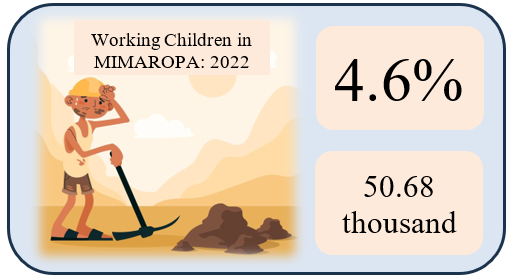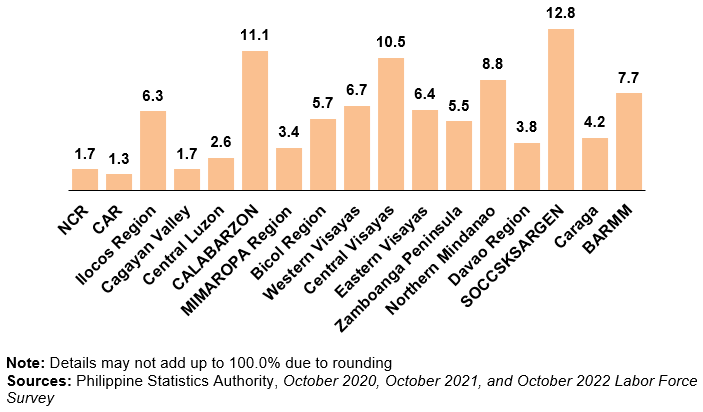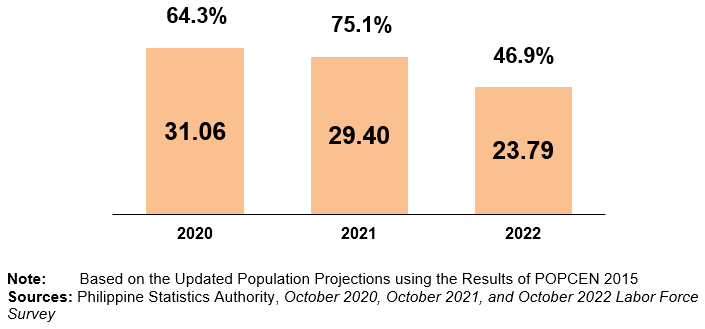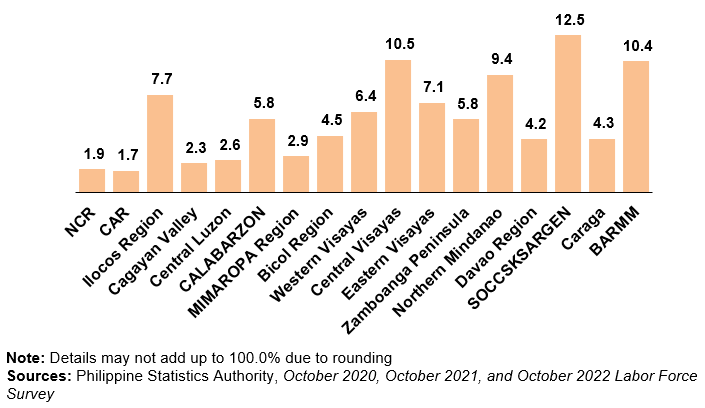
Proportion of working children aged 5 to 17 years old was estimated at 4.6 percent in MIMAROPA Region
In the MIMAROPA Region, the population of children aged 5 to 17 years was estimated at 1.10 million in 2022. This figure is higher than the 1.037 million reported in 2021 and the 1.035 million in 2020.
The percentage of working children aged 5 to 17 increased to 4.6 percent in 2022, up from 3.8 percent in 2021. In 2020, the proportion was 4.7 percent. In terms of numbers, there were approximately 50.68 thousand working children in this age group in 2022, an increase of 11.52 thousand from 39.16 thousand in 2021. In 2020, the estimated number of working children was 48.34 thousand. (Figure 1)
In national level, proportion of working children aged 5 to 17 was recorded at 4.7 percent in 2022 which translates at 1.48 million working children aged 5 to 17. It was estimated at 4.3 percent in 2021 and 2.8 percent in 2020.
Figure 1. Number (in thousand) and Proportion of Working Children, MIMAROPA Region: October 2020, October 2021, and October 2022

In the MIMAROPA Region, the estimate of 4.6 percent working children in 2022 represented 3.4 percent of the national total of 1.48 million working children. This proportion is relatively low compared to other regions, similar to the shares seen in CAR, NCR, Cagayan Valley, and Central Luzon. (Figure 2)
SOCCSKSARGEN had the highest share of working children in 2022 at 12.8 percent, followed by CALABARZON with 11.1 percent.
Figure 2. Percent Distribution of Working Children, by Region: October 2022

Child Laborers was estimated at 46.9 percent among working children in the region
Child labor includes working children who engaged in the following activities: (i) hazardous work (hazardous child labor) which encompasses undesirable activities or work done in hazardous environment (as identified in DOLE Order No. 04 (1999) on ‘Hazardous work and activities to persons below eighteen (18) years of age’), and work done for long hours of more than 40 hours and/or night time or the entire day by children in ages 15 to 17 years (Section 12A (2) and (3) of RA No. 9231); and (ii) work by children below fifteen (15) years of age in excess of the allowable work hours or less than 20 hours (Sec. 12A (1) of RA No. 9231).
In 2022, the estimated number of working children engaged in child labor was 23.79 thousand. This figure shows a decrease from the previous years, with 29.40 thousand reported in 2021 and 31.06 thousand in 2020. (Figure 3)
When considering the proportion of working children engaged in child labor, it was 46.9 percent in 2022. This represents a significant reduction compared to 75.1 percent in 2021 and 64.3 percent in 2020. These statistics indicate a downward trend both in the absolute number and the proportion of working children engaged in child labor over the three-year period.
Figure 3. Number (in thousand) and Proportion of Working Children engaged in Child Labor, MIMAROPA Region: October 2020, October 2021, and October 2022

In 2022, the MIMAROPA Region had 23.79 thousand working children engaged in child labor, representing 2.9 percent of the national total, which was estimated at 828.09 thousand. This share is relatively low, similar to the proportions found in other regions such as the CAR, NCR, Cagayan Valley, and Central Luzon. Despite being part of the national figure, these regions, including MIMAROPA, consistently reported lower percentages of child labor compared to other areas in the country, indicating a regional disparity in the prevalence of child labor.
Figure 4. Percent Distribution of Working Children engaged in Child Labor, by Region: October 2022

(SGD) LENI R. RIOFLORIDO
Regional Director
MLLM/OHG/EVC

